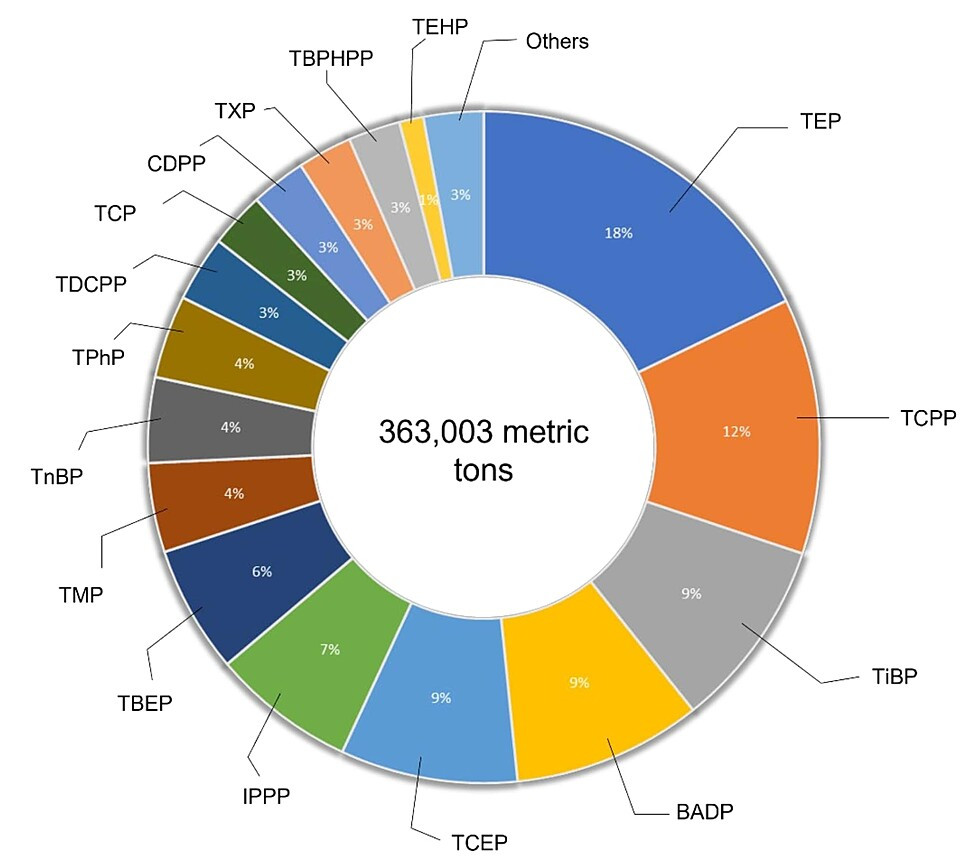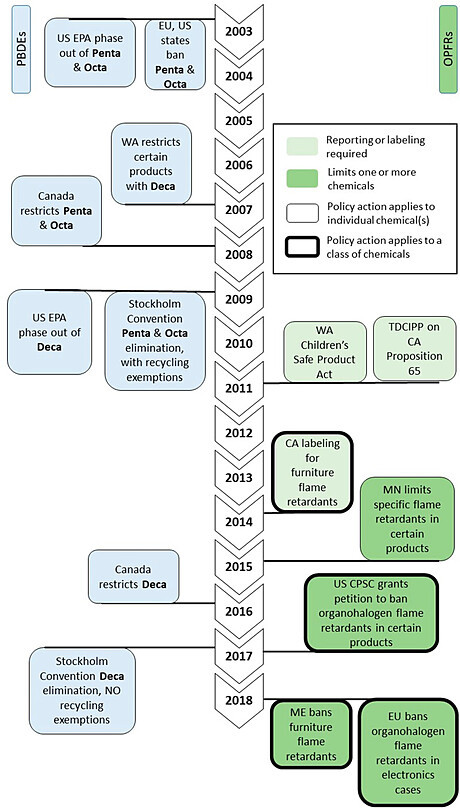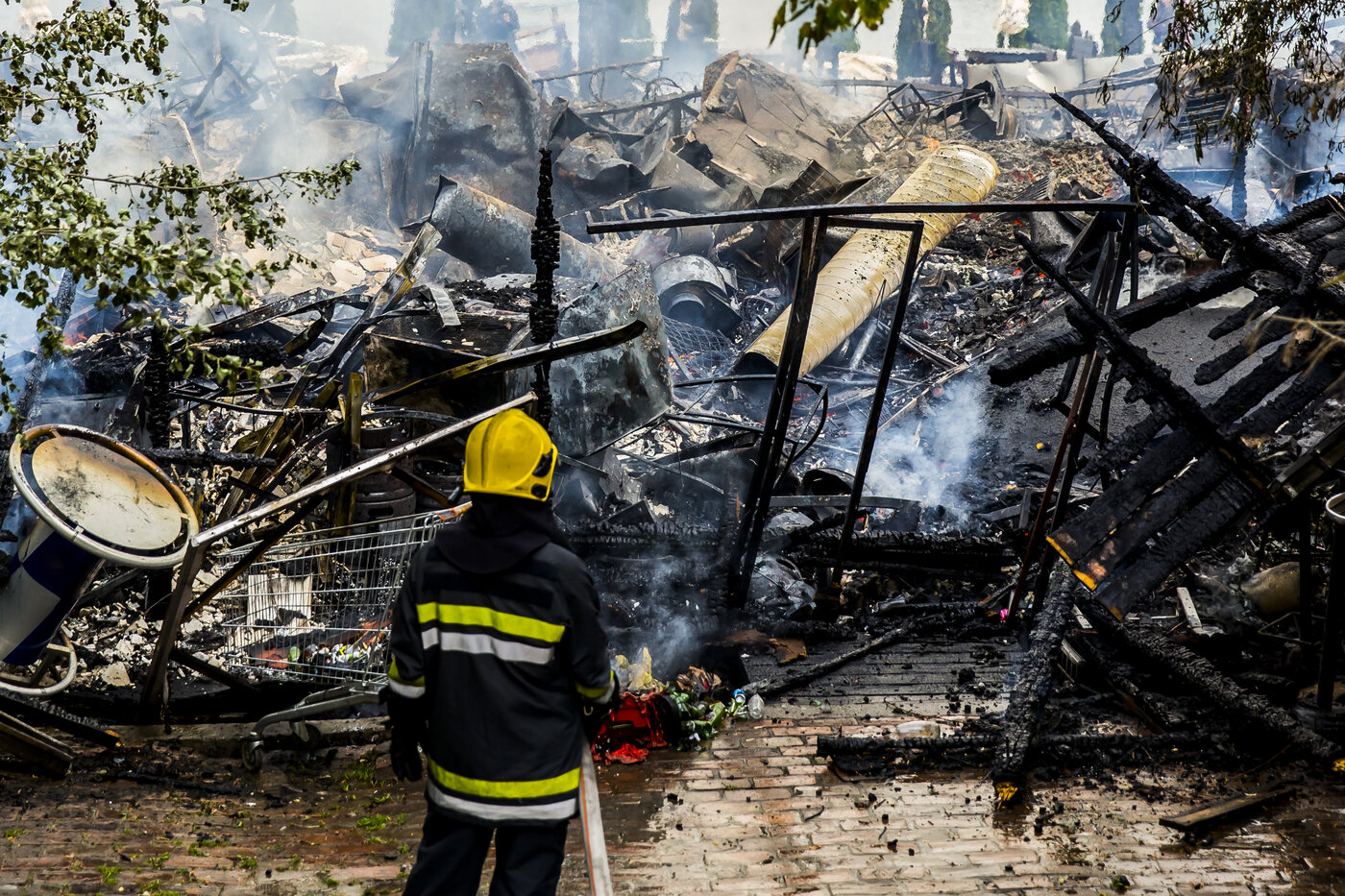There are hundreds of different flame retardants, but many share the following properties that make them especially concerning:1
- They are persistent. They do not easily break down, remaining in the environment for years.
- They bioaccumulate. They can build up in people and animals, especially higher up in the food chain.
- They are mobile. They readily leach from the products that they are used in and can be transported around the world, even to remote areas.
- They are toxic. While much is unknown about the health impacts of many specific flame retardants, we have accumulating evidence that the most commonly used classes of flame retardants have harmful effects, including increased cancer risk and impaired neurological and reproductive development.2
Types of Flame Retardants
Flame retardants are categorized based on chemical structure and properties.
Two commonly used classes of flame retardants are halogenated (or organohalogen) flame retardants and organophosphorus flame retardants.3
Halogenated Flame Retardants
These have been the most abundantly used flame retardants, added to electronics, furniture, building materials, and automobiles.
These chemicals do not dissolve easily in water; they adhere to particles and build up in river beds and lake sediment.4 They have been found in humans and animals.5
The following classes of flame retardants are sub-types of halogenated flame retardants:
Polybrominated biphenyls (PBBs)
PBBs were added to consumer products to meet flammability standards set in the 1970s. PBBs were phased out of use in 1976 because of concerns about their health effects and persistence.
Polybrominated diphenyl ethers (PBDEs)
PBDEs replaced PBBs. Over time, it became clear that PBDEs were a regrettable substitution for PBBs. PBDEs can build up in certain fish and mammals when they consume contaminated food or water.6
PBDEs do not chemically bind to the products they have been added to. They easily travel (migrate or leach) from these products into air and dust. The release of PBDEs from products typically increases with use and age. PBDEs are also released in the manufacturing process and during product disposal.
Most PBDEs have now been banned or phased out of production. They are now targeted for elimination under the Stockholm Convention.7 However, much like PBBs, they remain in the environment due to their extensive prior use and chemical persistence.
Tetrabromobisphenol A (TBBPA)
TBBPA is used widely in electronics, circuit boards, some textiles, and paper. It is globally the most highly produced brominated flame retardant, with human exposure to it widespread. It has been found in human tissue and household dust, as well as other places in the environment, including soil, water, and fish. In 2018 the International Agency for Research on Cancer (IARC) classified TBBPA as “probably carcinogenic to humans.”8
Hexabromocyclododecane (HBCD)
HBCD, also known as Cyclic Aliphatic Bromide Cluster, is an additive used in polystyrene foam building materials from which it can leach and attach to indoor dust. In 2013, HBCD was added to the Stockholm Convention list of dangerous chemicals to be eliminated from use.9 The Environmental Protection Agency (EPA) began a risk evaluation for HBCD in 2016. In 2022, EPA released the final revised risk evaluation, which found that “HBCD presents an unreasonable risk of injury to human health and the environment when evaluated under its conditions of use.”10
Organophosphate Flame Retardants (OPFRs)
With the phase out of PBDEs, OPFRs have often been used as replacements. The National Toxicology Program is assessing these replacements for potential hazards, using in vitro and alternative animal models.
Some of the replacement OPFRs have activity comparable to the phased-out PBDEs and structural similarities with organophosphorus insecticides, which are known to be neurotoxic.
Other Flame Retardants
The chlorinated organophosphate tris(1,3-dichloro-2-propyl)phosphate (TDCPP or Tris) is added to polyurethane foam used in upholstered furniture. It was banned in the 1970s from use in children’s pajamas due to its mutagenic properties, but is still found in households with foam, including baby products.
After a 2006 ban on pentaBDE, the use of TDCPP increased. In 2011, California added TDCPP to its Proposition 65 list of suspected carcinogens.
Aerial wildfire retardants are dropped from planes to put out wildfires. They are considered an important tool for fighting large-scale wildfires. The most commonly used is Phos-Chek. Phos-Chek contains about 80% water and 10% ammonium phosphate fertilizer. The rest is made up of undisclosed proprietary ingredients, such as thickening and coloring agents and corrosion inhibitors.
The main known concern is that excessive nutrients from Phos-Chek could cause algal blooms and starve water of oxygen. The proprietary ingredients could also have unknown impacts on watersheds.11
Health Impacts
As noted above, much is still unknown about the health impacts of many specific flame retardants. However, evidence of harmful effects is accumulating. Various classes of flame retardants have been associated with reproductive toxicity, cancer, impaired neurological development, endocrine disruption, immune disruption.12 The table below shows the associated health impacts of several major classes of flame retardants along with some specific chemicals of concern.
|
Exposure |
Associated Health Impacts |
|
PBDEs |
Endocrine disruption,13 lower birth weight and length,14 impaired neurological development in children,15 plus cancer16 and behavior changes17 in animal studies |
|
TBBPA |
|
|
HBCD |
Reproductive toxicity, neurotoxicity, and endocrine disruption19 |
|
TDCPP |
|
|
OPFRs |
Reproductive toxicity, neurotoxicity, and endocrine disruption21 |
Vulnerable Populations
Children
As flame retardants can affect the developing nervous system, children are particularly vulnerable. Their hand-to-mouth behaviors, increased breathing rates, and proximity to materials containing flame retardants increases their risk for exposure.
Investigations have found that children have a higher concentration of flame retardants circulating in their bodies than adults,22 and flame retardants have been found in toddler excrement. A 25-year Swedish study found that the concentration of PBDEs in breast milk doubled every five years during the 25-year period.23
Workers
Workers at sites handling products containing flame retardants are at a higher risk of exposure from burning, recycling, or dismantling these products, increasing the risk that chemicals will be absorbed by the body.24
Firefighters face a particularly increased risk of exposure. TDCPP, the chemical removed from children’s pajamas decades ago, is now found in fire stations at levels of concern. Researchers suspect firefighters are carrying it back on clothing and equipment after being exposed on the fire ground. Studies have shown that firefighters have elevated levels of flame retardants in their blood and urine, compared to the general population. Even with full protective turnout gear, firefighters’ exposures to flame retardants have been shown to spike when they respond to residential fires.25
Firefighters have been important advocates for getting flame retardants out of consumer products.26 In most cases, the flame retardants used in products do not effectively prevent fires. They do, however, make the smoke from fires more toxic.27 The Chicago Tribune highlighted the relationship between flame retardants and increased incidence of cancer in firefighters in their series, “Playing with Fire.”
Routes of Exposure
Chemicals can leach from products into dust and into the air, and then dust can transfer to hands and food where it is later ingested.
Flame retardants can also enter the environment through burning or dismantling e-waste. During manufacturing, these chemicals can enter surrounding air, water, and soil. Chemicals in air and water can travel great distances on air and water currents and are now found worldwide.
Flame retardants and other Persistent Organic Pollutants (POPs) are atmospherically transported from lower latitudes to the Arctic, where they bioaccumulate and biomagnify in the lipid-rich Arctic food webs.28 Levels of some retardants in the Arctic are extremely concerning.29
PBDEs are present in older furniture still in use. Plastics are another source of exposure. Plastics that contain PBDEs can be recycled into new products, including kitchen utensils and toys.30 Overall exposure levels to PBDEs have decreased since they were phased out.31 However, this progress is being offset by the increased use of replacement flame retardants.32
People are exposed primarily through diet and inhalation of off-gassing from products in the home and in cars, airplanes, and workplaces. House dust is a significant source of exposure.33
Burning of flame retardants during house fires is a special concern to firefighters who are often exposed to heavy amounts of smoke containing these chemicals. Materials treated with flame retardants have been shown to produce more carbon monoxide and soot when they burn. In addition, the smoke produced can contain elevated levels of flame retardants, dioxins, and furans.34
Reducing Exposures
Regulation
In 1975, California adopted a standard known as Technical Bulletin 117 (TB117) mandating that foam products meet an open-flame test for reduced flammability. Flame retardants were often added to products to meet this test. Because many manufacturers chose not to have different standards for products to be sold in California versus elsewhere, the California test became the de facto nationwide standard, and most foam products sold in the US contained high levels of these chemicals.35
A 2011 article reviewed evidence of both risks and benefits of flame retardants in furniture foam. The researchers' conclusions:
- The quantities of flame retardants found in residential furniture do not reduce the severity of home furniture fires.
- The California TB117 open-flame test for foam does not serve to prevent ignitions from small flame sources.
- There are no fire-safety benefits of TB117 foams.36
In 2013, California revised Technical Bulletin 117 to TB117-2013. Flame retardants are not needed in order to meet TB117-2013.37
In 2017, the U.S. Consumer Product Safety Commission (CPSC) granted a petition to ban the use of organohalogen flame retardants from many products, including children’s products and furniture. However, the ban does not apply to all organophosphates or other types of flame retardants.38 As of 2024, CPSC is still determining if additional flame retardants should be included in the 2017 ban.39 In 2020, California enacted a law banning the sale of upholstered furniture, juvenile products, and mattresses containing most flame retardants.40 Also in 2020, the United States adopted TB117-2013 as a national standard for flammability.41
As a result of health concerns, many PBDEs (which are a subclass of organohalogen FRs) have been phased out of use. However, they will persist in the environment for years and continue to bioaccumulate in people and animals. Once these chemicals are released into the environment, it becomes much harder to mitigate their health impacts.
In many cases, manufacturers replaced PBDEs with less-studied chemicals whose health implications were unknown, such as organophosphate flame retardants (OPFRs). OPFRs are structurally similar to neurotoxic organophosphate pesticides.
The chart below shows the estimated production of OPFRs in 2020. There is increasing evidence of their negative impact on human and ecological health.42
Estimated Production of OPFRs in 2020


The chart at right shows the timeline of regulations for PBDEs and OPFRs.45
This is an example of regrettable substitution, in which one chemical known to cause health harms is replaced by an alternative that may be equally or more harmful. Progress is being made to now regulate OPFRs. However, in the meantime, OPFRs continue to be manufactured and used in consumer products. From there, they will increasingly be released into the environment, bioaccumulate, and harm people and the environment.
Initial efforts to regulate PBDEs focused on individual chemicals within the class. As more data became available, it became clear that the entire class of PDBEs were problematic. The same process is now playing out with OPFRs. In order to avoid regrettable substitutions like this, we need stronger regulations to limit the use of classes of chemicals that are likely to do harm.

For more on flame retardants as a class of chemicals and regrettable substitution, see the Green Science Policy Institute’s pages on Flame Retardants and the Class Concept.
Personal Prevention
Ways to reduce your exposure to flame retardants:46
- Reduce dust levels by dusting with a damp rag, wet mopping, and vacuuming with a high-efficiency particulate air (HEPA) filter.
- Reduce dust by having a good ventilation system in your home.
- Replace upholstered furniture that has a TB 117 label. Look for upholstered furniture with a more recent TB 117-2013 label stating the item does not contain flame retardants.
- Wash your hands and those of your children often, especially before eating or preparing food. Hand-to-mouth contact exposes people to flame retardants.
- When purchasing new products, try to purchase baby products and furniture filled with cotton, polyester, or wool, instead of polyurethane foam.
- Cover and seal rips in upholstery that expose polyurethane foam, especially if the foam is loose and crumbling.
- Be careful when replacing old carpeting. The padding likely contains flame retardants. Avoid using rebonded carpet padding made from recycled or scrap polyurethane foam.
- Contact your mattress manufacturer to see whether your mattress is made with polyurethane foam that contains flame retardants. If it does, but you aren't ready to replace your mattress, consider purchasing a tightly woven allergen-barrier mattress casing to reduce the migration of flame retardants into dust.
- Tell manufacturers, retailers, and government agencies you want products without flame retardants.
For more on our work, click here to explore webinar recordings related to lead and environmental health.
CHE invites our partners to submit corrections and clarifications to this page. Please include links to research to support your submissions through the comment form on our Contact page.
This page was last revised in June 2024 by CHE’s Science Writer Matt Lilley, with input from Sharyle Patton, and editing support from Kristin Schafer.
Some information on this page is sourced from Toxipedia.

